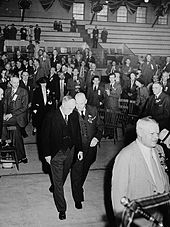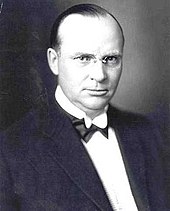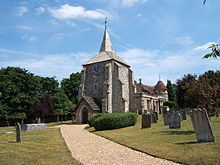Richard Bedford Bennett
Richard Bedford Bennett, 1st Viscount Bennett PC , KC (born July 3, 1870 in Hopewell , New Brunswick , Canada , † June 26, 1947 in Mickleham , Surrey , United Kingdom ) was the eleventh Prime Minister of Canada. His term in office lasted from August 7, 1930 to October 23, 1935. Bennett was a member of the Conservative Party .
Live and act
Youth and Studies
Richard Bedford Bennett was born in 1870 as the eldest of six children of Henry John Bennett (1842-1905) and Henrietta Stiles (1844-1914). The couple had been married since September 22, 1869 and had four of their children between 1870 and 1876. The Bennetts owned a shipyard on Hopewell Cape in southeast New Brunswick, founded by Richard's grandfather Nathan Murray Bennett. However, Henry John Bennett was unable to support his growing family with the income from shipbuilding , which declined due to increasing competition from steam engines and the Depression in the 1870s. Even his later activities as a trader, blacksmith and farmer could not prevent Richard Bennett and his siblings from growing up in relative poverty. Her mother was a member of the Wesleyan Methodist Church and she taught the value of hard work, charity, and frugality in her education. After making a small inheritance, Richard Bennett was able to attend Normal School in Fredericton when she was 16 . He then worked as a teacher in Irishtown north of Moncton . In 1888 he obtained a first class license and at the age of 18 became the head of a school in Douglastown , a district of Miramichi . At the same time he worked in his spare time for the law firm of Lemuel John Tweedie (1849-1917), later Premier of the Province of New Brunswick, in Chatham . In this way he managed to save enough money to be able to start a law degree at Dalhousie University in Halifax in the fall of 1890 . In 1893 he graduated with a Bachelor of Laws and the following year he received a lawyer license for New Brunswick.
Moved to Alberta and started his political career
After graduation, Bennett returned to the Chatham practice as a partner, renamed Tweedie and Bennett . In 1897 he moved to Calgary and became a junior partner in the practice of James Alexander Lougheed after obtaining a license to practice law in the Northwest Territories . This was followed with the appointment of a recommendation by the dean of law at Dalhousie University Richard Chapman Weldon (1849-1925). In 1907 Bennett received the title of Crown Attorney (KC). As the fledgling city of Calgary continued to grow, Bennett and Lougheed's legal practice gained clients and grew into a successful business by 1914. Bennett was also active in buying and selling land and became a partner and director of the Calgary Petroleum Products Company of entrepreneur William Stewart Herron.
Bennett's political career began in 1898, when he for the constituency of West Calgary in the Legislative Assembly of the North-West Territories ( legislative assembly of the Northwest Territories has been selected). He stayed there until its dissolution in 1905. After Alberta became province in 1905 , he was elected chairman of the newly formed Alberta Conservative Party . He ran for Calgary in the election for the Legislative Assembly of Alberta , but was not initially elected. He finally succeeded in doing this in 1909 together with two other members of the Conservatives, a socialist and 37 liberals. In parliament he soon became the spokesman for the outnumbered opposition and one of the few successful conservative politicians in Alberta. Among other things, he played an important role in uncovering a scandal over the funding of the Alberta and Great Waterways Railway , which in 1910 led to the resignation of Alexander Cameron Rutherford and his cabinet.
1911 joined Bennett from his position in the Legislative Assembly of Alberta and became Calgary in the lower house (House of Commons) selected . Prime Minister at the time was Robert Borden . Bennett's political stance is classified as Red Toryism by his biographers . Among other things, he campaigned for social benefits, trade unions and state controls in the economy. In his inaugural address on November 20, 1911, he argued that property interests should not be placed above human rights. It is the government's duty to ensure that this does not happen.
First World War and post-war period
During the First World War , Bennett was not admitted to the military for medical reasons. He served as the director of the Alberta Red Cross branch and administered the Canadian Patriotic Fund, which provided financial aid to families of soldiers. In 1915 he went to London as Borden's assistant to support the British government and accompanied him on his first visit to the Canadian armed forces in England and France. In 1916, Bennett became director general of the National Service, which compiled reports on the available Canadian soldiers and resources. In the following year he supported the Military Service Act , which obliged Canadians to do military service instead of relying on volunteers as before and which led to the conscription crisis. He opposed Borden's idea of uniting conservatives and liberals in the Unionist Party . In the 1917 election he supported the Conservatives, but did not run himself. In the following year, his differences with Borden intensified when the latter did not appoint him as a senator due to coalition agreements , but instead chose the liberal William James Harmer.
During the war, Bennett's legal office in Calgary had deteriorated economically as several employees had been drafted. Starting in 1918, Bennett was increasingly involved in the business of the match and paper company EB Eddy Company in Hull , Québec . The company's owner's widow, a long-time friend of Bennett, entrusted him with her financial affairs and bequeathed him shares in the company in her will in 1921, to which more were added after her brother's death in 1926, so that Bennett finally took over the management of the company. In 1922, after a 25-year business partnership, he separated from Lougheed, with whose work and decisions he was increasingly dissatisfied. The practice was split into three parties, with Bennett's office (Bennett, Hannah, and Sanford) taking key customers with it. In the mid-1920s, Bennett was doing well financially, with an income of $ 76,897 in 1924, of which only 25 percent came from his work as a lawyer. He earned mostly from dividends from corporate interests such as the Alberta Pacific Grain Company, of which he was temporarily president, Canada Cement and the EB Eddy Company. He was also a director of the Metropolitan Life Insurance Company in New York and on the board of directors of the Royal Bank of Canada . In 1930, his income was $ 262,176, with dividends increasing.
Minister and party leader

In 1920 Prime Minister Borden resigned and appointed Arthur Meighen as his successor. Meighen scheduled new elections for December 6, 1921 and asked Bennett to serve as his attorney general. With Canada in severe social and political crisis after the war, Bennett accepted to help restore order and law. He was sworn in on September 21, 1921. His term of office only lasted a few months, however, as the Conservatives were defeated in the 1921 general election. The Conservative Party won no lower house seat in the province of Alberta, Bennett himself lost in his constituency of Calgary West with a difference of 16 votes. In the 1925 general election he ran again and won this time with a comfortable majority in Calgary West. In this election, the conservatives achieved a majority, but the liberal William Lyon Mackenzie King continued to rule with a minority government, so that Bennett was initially unable to take up the ministerial post that Meighen had promised him again. Due to the King Byng affair , he was still appointed Minister of Finance and Acting Minister of the Interior and Minister of Mining from July 13 to September 24, 1926. However, this Conservative government ended after a vote of no confidence , dissolution of parliament and new elections . Prime Minister Meighten, who was voted out of office in his constituency, continued to run government until September 25, 1926. Then he gave his office to King and resigned as party chairman.
During the following time in the opposition, Bennett campaigned, among other things, for the introduction of contributory pensions and unemployment insurance. On October 12, 1927, he was elected the new party leader at a Conservative meeting in Winnipeg . Afterwards, as announced, he resigned his director post and sold part of the Eddy Company in order to be as free as possible from other obligations. He set up a central party office in Ottawa , which worked under the direction of Alexander Duncan McRae (1874-1946) with 27 employees. Since the party's finances, as well as the support in the media and the population, were very poor after the war policy of the Conservatives, this measure was mainly financed by senior party members. From his election as party chairman to May 1930, Bennett donated around $ 500,000, a fifth of which went to Québec , where the situation of the Conservatives was particularly difficult. With Bennett's dedicated work as opposition leader and local successes of conservative politicians such as Camillien Houde and Howard Ferguson (1870-1946), however, the situation improved markedly by 1929. Supported by his sister Mildred (1889-1938) Bennett went into the election campaign, where he used the new medium radio with more success than his opponent King. He also traveled around Canada, making several speeches a day, covering approximately 14,000 miles from June 9 to July 26. The main theme of his election campaign was combating rising unemployment, which King neglected. In the 1930 general election , the Conservatives finally won an absolute majority of the seats, while the Liberals had to return to the opposition after four years in office.
prime minister
On August 7, 1930, Bennett became Prime Minister , Secretary of State and Treasury and President of the Privy Council . He set up the 15th Cabinet , whose 19 members included Thomas Gerow Murphy (1883–1971) as Secretary of the Interior, Hugh Guthrie as Minister of Justice and Robert James Manion as Minister of Railways and Canals. Bennett called his cabinet more often than the average and was considered a demanding head of government, who rarely praised, as Manion complained to him in 1932. His first measures against the effects of the Great Depression included an expansion of protective tariffs on various products, which he hoped would support the Canadian manufacturers, as well as an Unemployment Relief Act , in which the federal government gave 20 million dollars to support public projects on federal and state levels Provincial level, such as building roads, bridges and canals, as well as reimbursing the costs incurred by cities and provinces through unemployment benefits.
At the Imperial Conference in London in the fall of 1930, Bennett offered the United Kingdom and all other parts of the British Empire preferential treatment in the Canadian market if they in return would grant Canada the same. This offer attracted a lot of media attention. The British government, which advocated free trade, did not initially comment on this and rejected it shortly after the conference ended. In 1931, Bennetts passed the Unemployment and Farm Relief Act , which provided $ 28 million, and similar measures followed annually until 1935. The economic situation in Canada remained critical, including falling wheat prices. Bennett again raised tariffs and tried to support local wheat producers, which resulted in the creation of the Canadian Wheat Board in 1935 . At the Imperial Conference in Ottawa in 1932, despite criticism for lack of preparation, he was able to achieve some benefits for Canadian agricultural products on the British market, so that exports there increased by 60 percent. Another issue that Bennett grappled with during his tenure was the regulation of the broadcast market in Canada. He advocated the establishment of state radio stations and the establishment of regulations for radio programs in order to provide the population with more education rather than entertainment.
Essentially, during his reign, Bennett relied on laissez-faire in economic policy and hoped to stabilize Canada's economic situation through protective tariffs and trade advantages in the Empire. However, this did not solve the serious problems associated with depression. Unemployment in Canada had reached 27 percent in 1933 and the budget deficit was $ 150 million. It was not until shortly before the general election in 1935 that Bennett changed his strategy and began to present the so-called Bennett's New Deal in radio broadcasts from January 2, 1935 . In it, he promised, among other things, a more progressive tax system, minimum wages, a cap on weekly working hours, support programs for agriculture and improvements in the area of social security. In some respects, his plan was similar to the New Deal of Franklin D. Roosevelt . With this change of direction, however, he aroused suspicion in his own ranks of the conservatives and he did not succeed in influencing public opinion in his favor. In the general election in October, the Liberals won an absolute majority of the seats and the Conservatives went into the opposition. Bennett's tenure as Prime Minister ended on October 22nd. Until July 6, 1938 he remained party chairman and active leader of the opposition. Then he resigned, mostly for health reasons. Bennett suffered from heart problems and was overweight. In the same year, his close sister Mildred, with whom he had lived until their wedding in 1931, died of breast cancer at the age of 49. After Bennett's resignation, Manion took over the party leadership.
Last years in the UK
After his resignation, Bennett decided to leave Canada, among other things to avoid public pressure. In August 1938 he traveled to England and took over the Juniper Hill estate near Box Hill in Surrey on November 1st . After some renovation work and clarification of final matters, he resigned his seat in the House of Commons for Calgary West on January 28, 1939, and on the same evening finally left Canada on the ship Montclare from Halifax. In England he became a member of various organizations and remained active as a popular speaker. For the support of Lord Beaverbrook and his Ministry of Aircraft Production, Winston Churchill Bennett offered the title of Viscount Bennett of Mickleham, Hopewell and Calgary and a seat in the House of Lords (1941-1947). Bennett's health deteriorated increasingly, and in 1944 he was also diagnosed with diabetes. On the evening of June 26, 1947, he took a hot bath and died of a heart attack. He was found dead the next morning and buried in St. Michael's Churchyard near Mickleham, Surrey. A memorial service was held at Westminster Abbey on July 4th . Bennett was never married and had no children.
See also
literature
- Richard Bedford Bennett . In: Dictionary of Canadian Biography . 24 volumes, 1966–2018. University of Toronto Press, Toronto ( English , French ).
- Richard Bedford Bennett - biographical information on the website of the Canadian Parliament (English)
- Bruce Hutchison : Mr. Prime Minister 1867–1964 . Longmans Canada, Toronto 1964.
Web links
- Literature by and about Richard Bedford Bennett in the WorldCat bibliographic database
- Richard Bedford Bennett in the Britannica (English)
- Biography (English)
- Biography, speeches, bibliography and personal life on the Library and Archives Canada website
- Newspaper article about Richard Bedford Bennett in the 20th century press kit of the ZBW - Leibniz Information Center for Economics .
Individual evidence
- ↑ a b c d e f g h i P. B. Waite: Richard Bedford Bennett In: Dictionary of Canadian Biography. Volume XVII, Toronto, pp. 1941–1950, accessed May 18, 2013.
- ^ W. Stewart Wallace: Bennett, Richard Bedford. In: The encyclopedia of Canada. University Associates of Canada, Toronto 1935-1937, via the Canadian Biographical Archive, p. 272.
- ^ BM Greene: Bennett, Richard Bedford. In: Who's who in Canada: including the British possessions in the Western hemisphere. 1927. An illustrated biographical record of men and women of the time. International Press, Toronto 1927, via the Canadian Biographical Archive, p. 271.
- ^ Hector Charlesworth: Bennett, Richard Bedford. In: A cyclopaedia of Canadian biography: brief biographies of persons distinguished in the professional, military and political life, and the commerce and industry of Canada, in the twentieth century. Hunter-Rose, Toronto 1919, via the Canadian Biographical Archive p. 269.
- ^ Hector Charlesworth: Bennett, Richard Bedford. In: A cyclopaedia of Canadian biography: brief biographies of persons distinguished in the professional, military and political life, and the commerce and industry of Canada, in the twentieth century. Hunter-Rose, Toronto 1919, via the Canadian Biographical Archive p. 270.
- ↑ Richard Bedford Bennett parl.gc.ca, accessed on May 20, 2013.
- ^ Unemployment Relief Acts archives.gnb.ca, May 20, 2013.
- ^ Bennett's New Deal In: The Canadia Encyclopedia. Retrieved May 20, 2013.
- ^ Richard Bedford Bennett In: Britannica. Retrieved May 20, 2013.
- ↑ Richard Bedford Bennett In: Find a Grave , accessed May 20, 2013.
| personal data | |
|---|---|
| SURNAME | Bennett, Richard Bedford |
| ALTERNATIVE NAMES | Bennett, Richard Bedford, 1st Viscount Bennett |
| BRIEF DESCRIPTION | Canadian Prime Minister |
| DATE OF BIRTH | July 3, 1870 |
| PLACE OF BIRTH | Hopewell , New Brunswick , Canada |
| DATE OF DEATH | June 26, 1947 |
| Place of death | Mickleham , Surrey , United Kingdom |





